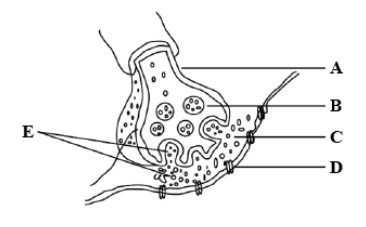
In the following diagram showing axon terminal and synapse A, B, C, D and E respectively represents.

1) A- axon terminal, B- synaptic cleft, C- synaptic vesicles, D- neurotransmitters, E- receptors
2) A- axon terminal, B- synaptic vesicle, C- synaptic cleft, D- receptor, E- neurotransmitters
3) A- synaptic cleft, B- synaptic vesicles, C- axon terminal, D- neurotransmitters, E- receptors
4) A- synaptic cleft, B- axon terminal, C- synaptic vesicles, D- neurotransmitters, E- receptors

Answer
535.8k+ views
Hint: The image shows a process known as nerve impulse release, which is transmitted from one cell to another at either an electrical or a chemical synapse.
Complete answer
Axon terminals on the presynaptic side of the synapse consist of neurotransmitters packed inside synaptic vesicles. The axon terminal releases neurotransmitter chemicals into the synaptic cleft. A synaptic cleft is a gap present between the terminals and the dendrite of the next neuron. The dendrite receptors of the postsynaptic neuron receive these neurotransmitters. This is how nerve impulses are passed through neurons.
A) An axon terminal is an enlarged or club shaped part of the nerve cell that makes synaptic connections with another nerve cell. The gap junction between the two cells carries electrical signals and small molecules from one terminal to the next cell.
B) Synaptic vesicles are small vesicles at the axon terminal that store the neurotransmitters that are released at the synapse. The release occurs by a voltage-dependent calcium channel. These vesicles are vital for carrying out the nerve impulse release between neurons and are constantly recreated by the cell.
C) A synaptic cleft is a gap present between two or more neurons that helps the nerve impulse to pass from one neuron to another. This cleft also acts as a site of action for various drugs. The drugs are used for various neurologic conditions and they can be agonists or antagonists of the neurotransmitters.
D) The receptor protein present on the synaptic membrane receives the neurotransmitters from the nerve cell.
E) Neurotransmitters, or chemical messengers, are a group of chemicals made by the nerve cell to transmit the message. The target can be another nerve cell, a muscle cell or a gland cell. This allows the transmission of neural signals throughout the nervous system.
Hence, the correct option is option B, ‘A- axon terminal, B- synaptic cleft, C- synaptic vesicles, D- receptor, E-neurotransmitters.
Note: The axon terminal and the synapse have various parts which are equally important in the transmission of nerve impulses. A slight change in any of the parts can lead to abnormalities.
Complete answer
Axon terminals on the presynaptic side of the synapse consist of neurotransmitters packed inside synaptic vesicles. The axon terminal releases neurotransmitter chemicals into the synaptic cleft. A synaptic cleft is a gap present between the terminals and the dendrite of the next neuron. The dendrite receptors of the postsynaptic neuron receive these neurotransmitters. This is how nerve impulses are passed through neurons.
A) An axon terminal is an enlarged or club shaped part of the nerve cell that makes synaptic connections with another nerve cell. The gap junction between the two cells carries electrical signals and small molecules from one terminal to the next cell.
B) Synaptic vesicles are small vesicles at the axon terminal that store the neurotransmitters that are released at the synapse. The release occurs by a voltage-dependent calcium channel. These vesicles are vital for carrying out the nerve impulse release between neurons and are constantly recreated by the cell.
C) A synaptic cleft is a gap present between two or more neurons that helps the nerve impulse to pass from one neuron to another. This cleft also acts as a site of action for various drugs. The drugs are used for various neurologic conditions and they can be agonists or antagonists of the neurotransmitters.
D) The receptor protein present on the synaptic membrane receives the neurotransmitters from the nerve cell.
E) Neurotransmitters, or chemical messengers, are a group of chemicals made by the nerve cell to transmit the message. The target can be another nerve cell, a muscle cell or a gland cell. This allows the transmission of neural signals throughout the nervous system.
Hence, the correct option is option B, ‘A- axon terminal, B- synaptic cleft, C- synaptic vesicles, D- receptor, E-neurotransmitters.
Note: The axon terminal and the synapse have various parts which are equally important in the transmission of nerve impulses. A slight change in any of the parts can lead to abnormalities.
Recently Updated Pages
Master Class 12 Business Studies: Engaging Questions & Answers for Success

Master Class 12 Economics: Engaging Questions & Answers for Success

Master Class 12 English: Engaging Questions & Answers for Success

Master Class 12 Maths: Engaging Questions & Answers for Success

Master Class 12 Social Science: Engaging Questions & Answers for Success

Master Class 12 Chemistry: Engaging Questions & Answers for Success

Trending doubts
What is meant by exothermic and endothermic reactions class 11 chemistry CBSE

Which animal has three hearts class 11 biology CBSE

10 examples of friction in our daily life

One Metric ton is equal to kg A 10000 B 1000 C 100 class 11 physics CBSE

1 Quintal is equal to a 110 kg b 10 kg c 100kg d 1000 class 11 physics CBSE

Difference Between Prokaryotic Cells and Eukaryotic Cells




